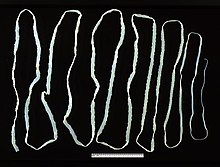| Taenia saginata | |
|---|---|

| |
| Scientific classification | |
| Domain: | Eukaryota |
| Kingdom: | Animalia |
| Phylum: | Platyhelminthes |
| Class: | Cestoda |
| Order: | Cyclophyllidea |
| Family: | Taeniidae |
| Genus: | Taenia |
| Species: | T. saginata
|
| Binomial name | |
| Taenia saginata Goeze, 1782
| |
Taenia saginata (synonym Taeniarhynchus saginatus), commonly known as the beef tapeworm, is a zoonotic tapeworm belonging to the order Cyclophyllidea and genus Taenia. It is an intestinal parasite in humans causing taeniasis (a type of helminthiasis) and cysticercosis in cattle. Cattle are the intermediate hosts, where larval development occurs, while humans are definitive hosts harbouring the adult worms. It is found globally and most prevalently where cattle are raised and beef is consumed. It is relatively common in Africa, Europe, Southeast Asia, South Asia, and Latin America.[1] Humans are generally infected as a result of eating raw or undercooked beef which contains the infective larvae, called cysticerci. As hermaphrodites, each body segment called proglottid has complete sets of both male and female reproductive systems. Thus, reproduction is by self-fertilisation. From humans, embryonated eggs, called oncospheres, are released with faeces and are transmitted to cattle through contaminated fodder. Oncospheres develop inside muscle, liver, and lungs of cattle into infective cysticerci.[2]
T. saginata has a strong resemblance to the other human tapeworms, such as Taenia asiatica and Taenia solium, in structure and biology, except for few details. It is typically larger and longer, with more proglottids, more testes, and higher branching of the uteri. It also lacks an armed scolex unlike other Taenia. Like the other tapeworms, it causes taeniasis inside the human intestine, but does not cause cysticercosis. Its infection is relatively harmless and clinically asymptomatic.[3][4]
- ^ Eckert J. (2005). "Helminths". In Kayser, F.H.; Bienz, K.A.; Eckert, J.; Zinkernagel, R.M. (eds.). Medical Microbiology. Stuttgart: Thieme. pp. 560–562. ISBN 9781588902450.
- ^ Somers, Kenneth D.; Morse, Stephen A. (2010). Lange Microbiology and Infectious Diseases Flash Cards (2nd ed.). New York: Lange Medical Books/ McGraw-Hill. pp. 184–186. ISBN 9780071628792.
- ^ Bogitsh, Burton J.; Carter, Clint E. (2013). Human Parasitology (4th ed.). Amsterdam: Academic Press. pp. 244–245. ISBN 9780124159150.
- ^ Winn Jr. Washington; Allen, Stephen; Janda, William; Koneman, Elmer; Procop, Gary; Schreckenberger, Paul; Woods, Gail (2006). Koneman's Color Atlas and Textbook of Diagnostic Microbiology (6th ed.). Philadelphia: Lippincott Williams & Wilkins. pp. 1282–1284. ISBN 9780781730143.